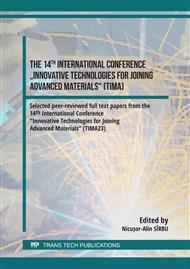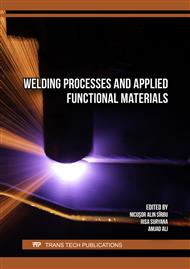[1]
Soltan, H., Omar, M. A roadmap for selection of metal welding process: a review and proposals. Weld World 66, 2639–2675 (2022)
DOI: 10.1007/s40194-022-01379-1
Google Scholar
[2]
Information on: https://www.claravision.com/en/produit/structureexpert-weld-5-weld-measurement/#:~:text=The%20StructureExpert%20Weld%20,014%2C%20PSA%20B13%201540%E2%80%A6
Google Scholar
[3]
Kumar, S., Gaur, V. & Wu, C. Machine learning for intelligent welding and manufacturing systems: research progress and perspective review. International Journal Advanced Manufacturing Technology 123, 3737–3765 (2022)
DOI: 10.1007/s00170-022-10403-z
Google Scholar
[4]
Woo, D.; Kitamura, M. Numerical Prediction of Welding Distortion Considering Gravity Force on General Ship Grillage Structure by Elastic Finite Element Method Using Inherent Strain. Journal of Marine Science and Engineering, 8(6), 454 (2020)
DOI: 10.3390/jmse8060454
Google Scholar
[5]
Liao, P, Guixiong, L. Pressure vessel-oriented visual inspection method based on deep learning. PLoS One, 2022 May 2;17(5)
DOI: 10.1371/journal.pone.0267743
Google Scholar
[6]
Shome, M.; Tumuluru, M. (Eds.) Welding and Joining of Advanced High Strength Steels (AHSS); Woodhead Publishing Series in Welding and Other Joining Technologies;Woodhead: Cambridge, UK, (2015)
DOI: 10.1016/b978-0-85709-436-0.09002-0
Google Scholar
[7]
N. Azad, M. Iranmanesh, and A. Rahmati Darvazi, A study on the effect of welding sequence on welding distortion in ship deck structure. Ships and Offshore Structures, vol. 15, no. 4, p.355–367, (2020).
DOI: 10.1080/17445302.2019.1619898
Google Scholar
[8]
Choudhary, S., Yadava, V., & Dixit, U. S. A review on hybrid welding process and its optimization techniques. International Journal of Advanced Manufacturing Technology, 112(5-6), 1429-1446, (2021)
Google Scholar
[9]
Sun, G., Wang, Z., Lu, Y., Mingzhi, C., & Kun, Y. Underwater laser welding/cladding for high-performance repair of marine metal materials: A review. Chinese Journal of Mechanical Engineering, 35(5), 1-19, (2022)
DOI: 10.1186/s10033-021-00674-0
Google Scholar
[10]
Yongtai K., Jaweoong K., Sungwook K., A Study on Welding Deformation Prediction for Ship Blocks Using the Equivalent Strain Method Based on Inherent Strain, Journal of Applied Sciences, 9(22), (2019)
DOI: 10.3390/app9224906
Google Scholar
[11]
Navid A., Mehdi I., Armin R.D., A study on the effect of welding sequence on welding distortion in ship deck structure, Engineering & Technology Journal, 15(2):1-13, (2019)
Google Scholar



